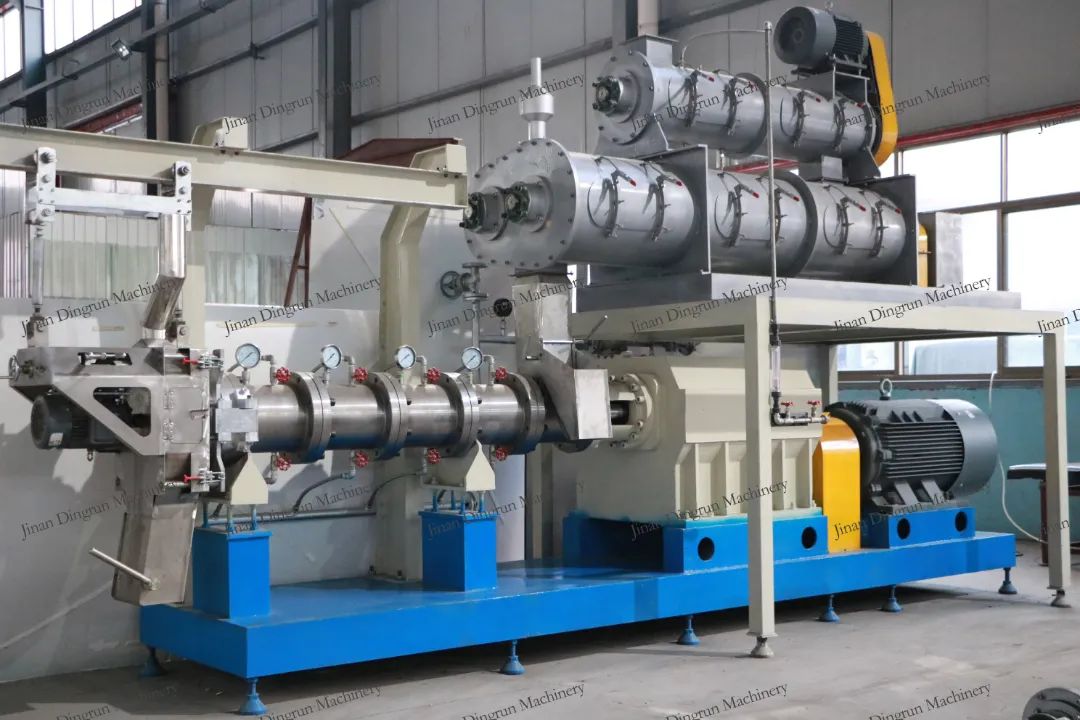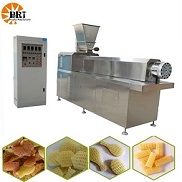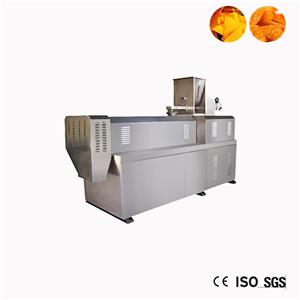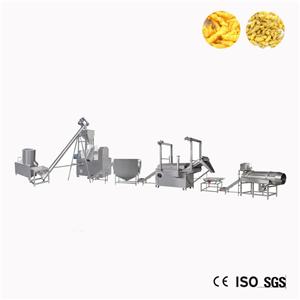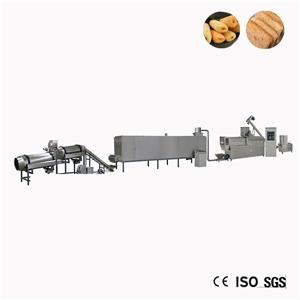How to choose aquatic fish feed equipment
How to choose aquatic fish feed equipment
Characteristics of aquatic feed:
1. Small particle size. Due to the short digestive tract and related physiological characteristics of aquatic animals, in order to speed up digestion and absorption, the crushing particle size of aquatic feed should be smaller than that of livestock and poultry feed. For example, the particle size of eel and shrimp feed should reach 80 ~ 120 mesh.
2. High protein content and low carbohydrate content. The protein content of livestock and poultry feed is generally less than 20%, while the protein content of aquatic animal feed is mostly 30% - 40%, and the protein content of turtle and eel feed is as high as 65% - 70%.
3. Pellet feed has a compact structure and high cohesiveness and water resistance. Shrimp feed requires the stability of pellet feed in water for more than 2 hours.
4. Cross contamination is strictly prohibited in the production of aquatic feed. Some raw materials need aseptic treatment. The selected equipment is easy to clean and has little residue. Especially in the production of shrimp and eel feed, it is not allowed to produce other kinds of feed at the same time to prevent cross contamination.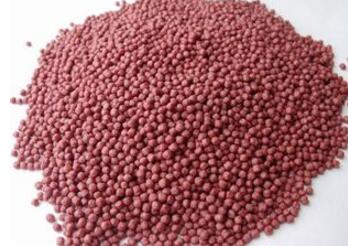
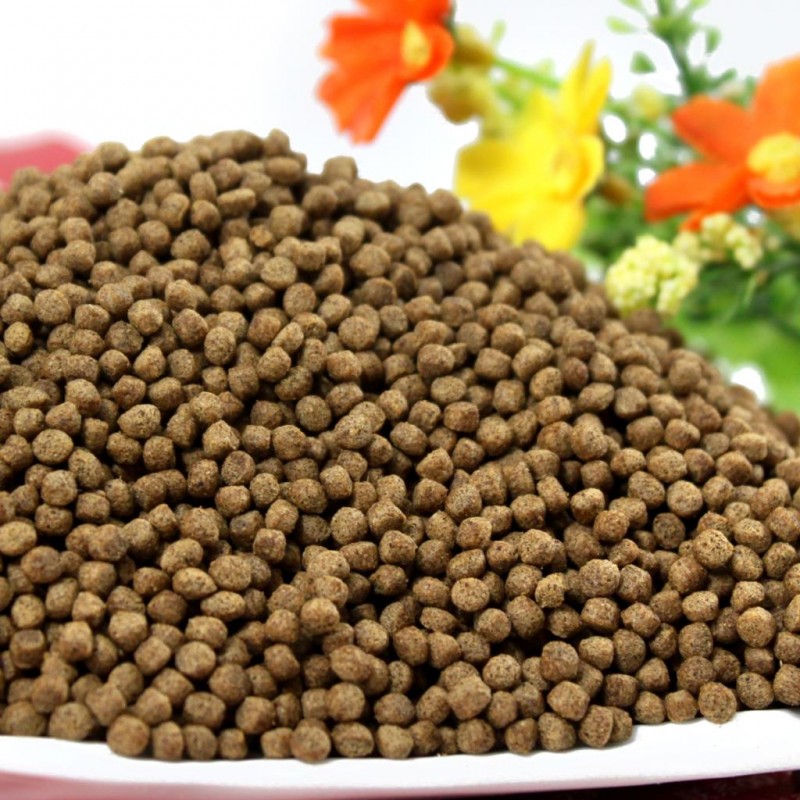
Small pellet feed
To produce high-quality aquatic feed, we must rely on scientific and reasonable processing technology and combine it with advanced, reliable and stable processing machinery. In this regard, the selection of processing equipment is particularly critical.
Selection of crushing equipment:
Generally, when producing ordinary fish feed, the particle size of raw materials is required to be about 40 mesh ~ 60 mesh, but when producing special aquatic pellet feed (shrimp feed, eel feed, turtle feed, etc.), the particle size of raw materials must be more than 80 mesh. The crushing particle size of raw materials determines the surface area of feed composition. The finer the particle size, the larger the surface area. Before granulation, it has a strong ability to absorb water in steam, which is conducive to conditioning and particle forming, so that the granular material has good water stability. At the same time, it can prolong the residence time in aquatic products, with good absorption effect, improve the feeding return and reduce water pollution. In order to achieve the ideal crushing particle size, the hammer crusher commonly used in the past is no longer suitable for the production of fish feed. At present, the "water drop" crusher popular at home and abroad is an advanced crusher model launched by developed countries in Europe and the United States in the 1990s. This machine fully exploits the advantages of the horizontal crusher, and uses a unique design idea. One crusher can form two kinds of hammer screen gaps, which can be used for ordinary crushing and fine crushing respectively. The crushing particle size is more uniform, and the particle size of fine crushing meets the production requirements of ordinary fish feed.
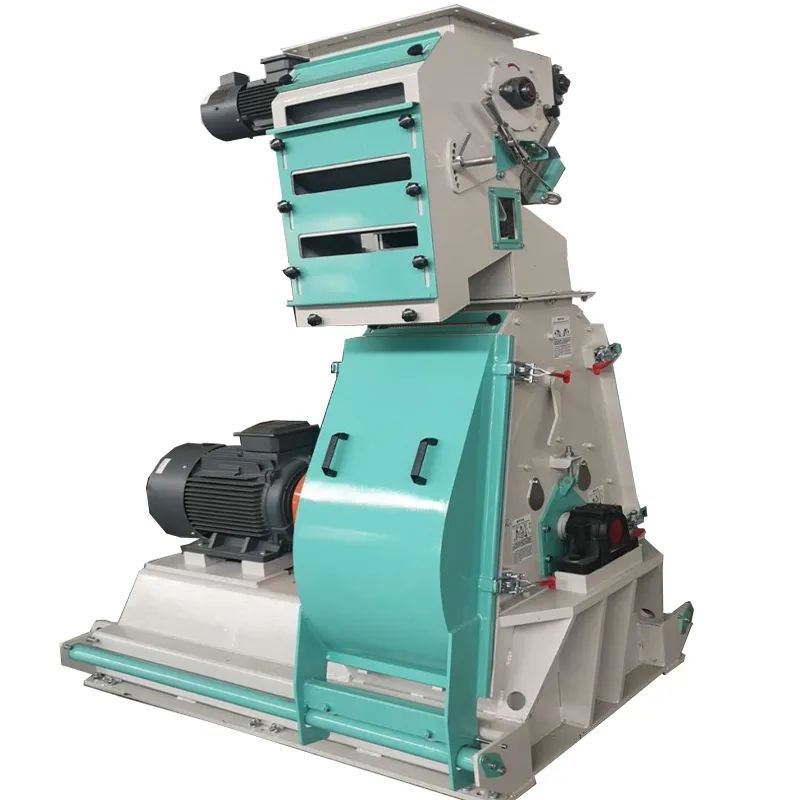
01 secondary crushing system
The micro powder crushing of aquatic feed often adopts the secondary crushing process, that is, coarse crushing first and then micro crushing, of which the second micro crushing. In the past, many feed factories used micro crushers and micro graders to achieve the required crushing particle size. This process covers a large area, and the crushing particle size is achieved by replacing the sieve plates with different apertures and adjusting the air volume of the system. It is easy to cause the temperature of the crushed materials to rise sharply, the nutritional components to be destroyed, and the screen blocking phenomenon often occurs, resulting in equipment wear and energy consumption. If the sieveless micro crusher is selected, the influence of the screen plate can be eliminated. The micro crusher with its own classifier can eliminate the return material treatment, with low material temperature, low power consumption and high output. The thickness and fineness can be adjusted on demand, and there is no need to be equipped with another micro classifier.
Vertical shaft micro pulverizer is a micro pulverizing equipment integrating crushing, screening and separation, which can meet the crushing particle size requirements of special aquatic feed. Because the crushing room and classification room are located in the same body, the equipment can complete the crushing, wind screening, separation and re crushing processes at the same time, and can effectively prevent over crushing. It contains high-precision micron wind classification, and the crushed particles can reach 60 ~ 200 mesh, and can be adjusted arbitrarily. The temperature rise of crushed materials is low, especially for heat sensitive materials. The whole process has compact structure, small floor area, low power consumption per ton of feed, uniform product particle size and high output. It is an ideal micro crushing equipment for the production of special aquatic feed.

Superfine grinding unit
02 selection of mixing equipment
The mixer is one of the key equipment of the feed plant, and the batching and mixing system is an important section of the whole feed plant. The performance and use effect of the mixer directly affect the production efficiency and product quality of the feed plant. Generally, the mixer used in feed factories is still dominated by the conventional leaf belt horizontal spiral mixer. This mixer has a long mixing cycle, and the mixing uniformity is not suitable for the production of aquatic feed. In recent years, with the rapid development of high-performance computers, batching scales and electronic technology, its performance is better than that of ordinary computer batching scales, and its batching accuracy is high, especially the batching cycle has been gradually shortened to about 2 minutes. Therefore, an ideal mixer should be selected in the batching and mixing section. The production cycle of the mixer should be equal to or similar to that of the batching scale, so as to ensure that the batching and mixing system has accurate proportioning, high mixing quality and normal operation, so that the productivity of this section can reach the best state, so as to effectively ensure the mixing effect, improve production and reduce costs. From this point of view, the current conventional leaf belt horizontal screw mixer can no longer be used with more and more advanced computer batching scales, which obviously hinders the improvement of productivity in this important link of batching and mixing in feed plants.
To sum up, it is best to choose horizontal double shaft paddle mixer for the production of aquatic feed. This double shaft paddle efficient mixer uses a new mixing mechanism and can achieve the required mixing uniformity. The machine uses the principle of instantaneous weight loss to make the materials mechanically affected in the body produce an all-round composite cycle, which is widely staggered without dead angles, so as to achieve uniform diffusion and mixing. The whole mixing process is mild, without segregation, and will not damage the original physical state of the materials. The mixing uniformity is high, the best mixing time is 30 seconds to 120 seconds, and the filling amount has a wide range. The discharging adopts the bottom discharge large door structure, and the discharging is rapid without residue; The discharge door is sealed reliably without material leakage; The discharge control can be electric or pneumatic as required. The machine is equipped with a liquid adding pipe, which can add oil and other liquids, mainly soybean oil, rapeseed oil and fish oil. The purpose of adding: (1) increase the energy value of feed, so that fish and shrimp grow fatter. (2) Enhance the protection of water-soluble vitamins. The amount of oil can be determined according to the variety of aquatic animals and feed materials.
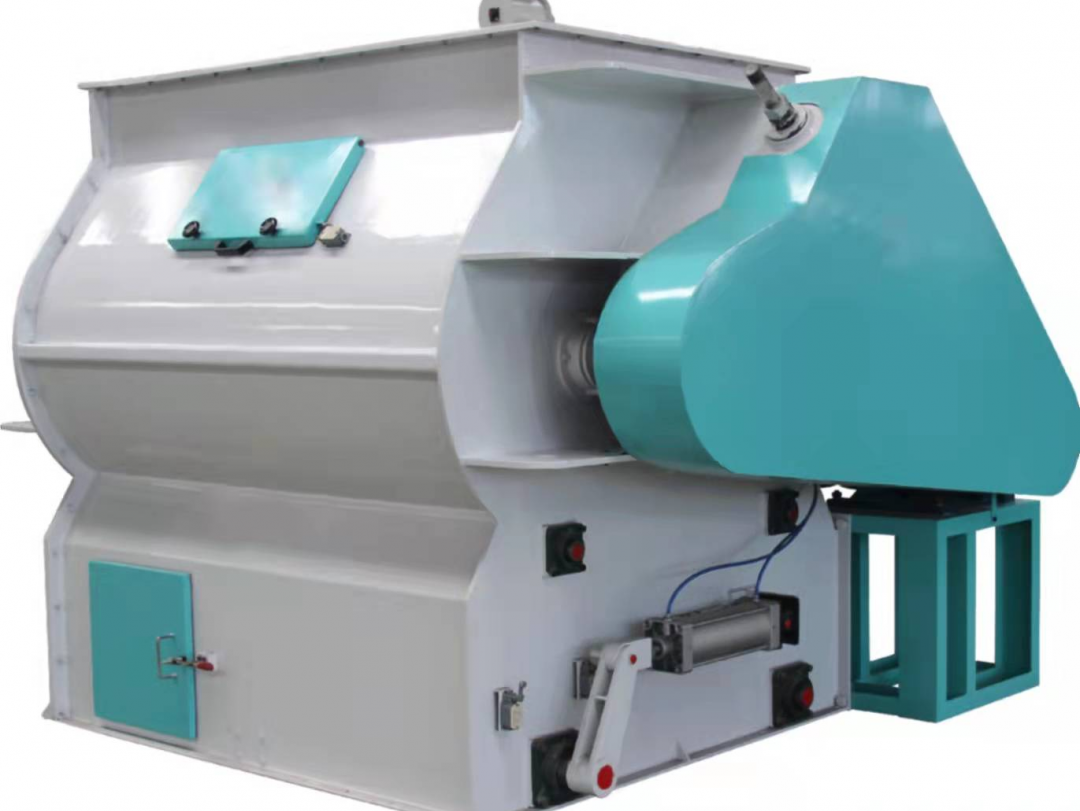
Double shaft paddle mixer
Selection of twin screw extruder:
Feed expansion technology is mainly used in the production of special aquatic feed, pet feed and other animal feed. In addition to the advantages of general full price pellet feed, expanded feed can also improve the digestion and absorption rate of feeding animals and effectively prevent animal digestive tract diseases. Expanded feed is not only suitable for materials with high starch and fat content because of the gelatinization of starch, but also because of the high temperature and high pressure ripening effect, the disinfection and sterilization effect is more obvious, and the applicability is strong. The feed resources that can be expanded are more extensive. It is because of so many advantages of puffing processing that more and more feed factories begin to puff aquatic feed. The main working principle of the extruder used is that the powdery material containing a certain amount of starch (more than 20%) is quenched and tempered by the conditioner, so that the moisture content of the material can reach 25% - 27%, and the temperature can rise to 80 ℃ - 100 ℃. The extruder is composed of feeding system, transmission system, extrusion system, discharge mold and electrical control system. The quenched and tempered material enters the screw extrusion area. As the volume of the extrusion area gradually decreases along the axis, the pressure on the material gradually increases, and its compression ratio can reach 4 ~ 10. The material is extruded and pushed by the screw. At the same time, with strong shear and friction, the pressure and temperature rise sharply. Under the action of high temperature and high pressure, the starch in the material can basically gelatinize completely and the protein is partially deformed. When the material is extruded out of the die hole by great pressure, it suddenly leaves the body and enters the atmosphere, and the temperature and pressure drop suddenly. Under the joint action of pressure difference and temperature difference, the feed volume expands rapidly, and the material flashes, that is, the water evaporates rapidly, dehydrates and solidifies, and then achieves the required shapes and structures through the customized discharge die, which makes the expanded pellet feed.
Dse-75s produces 1-1.5 tons per hour
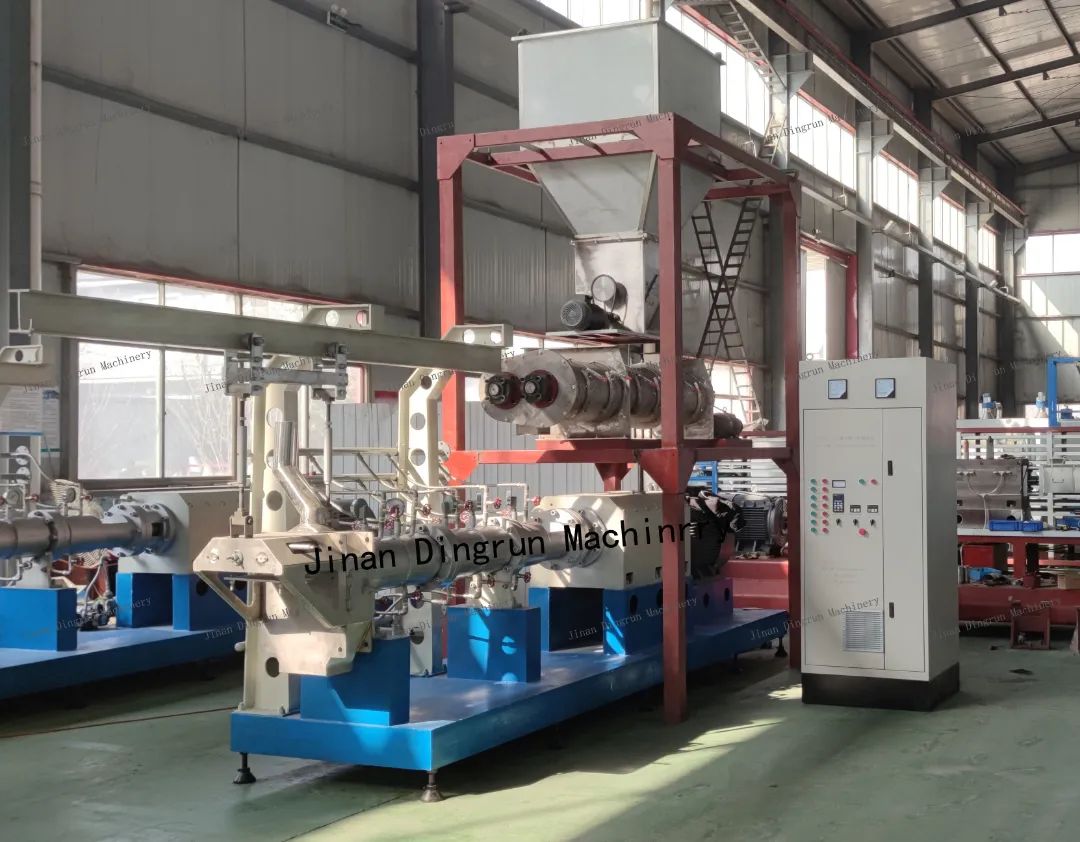
Dse-90 produces 1.5-2 tons per hour
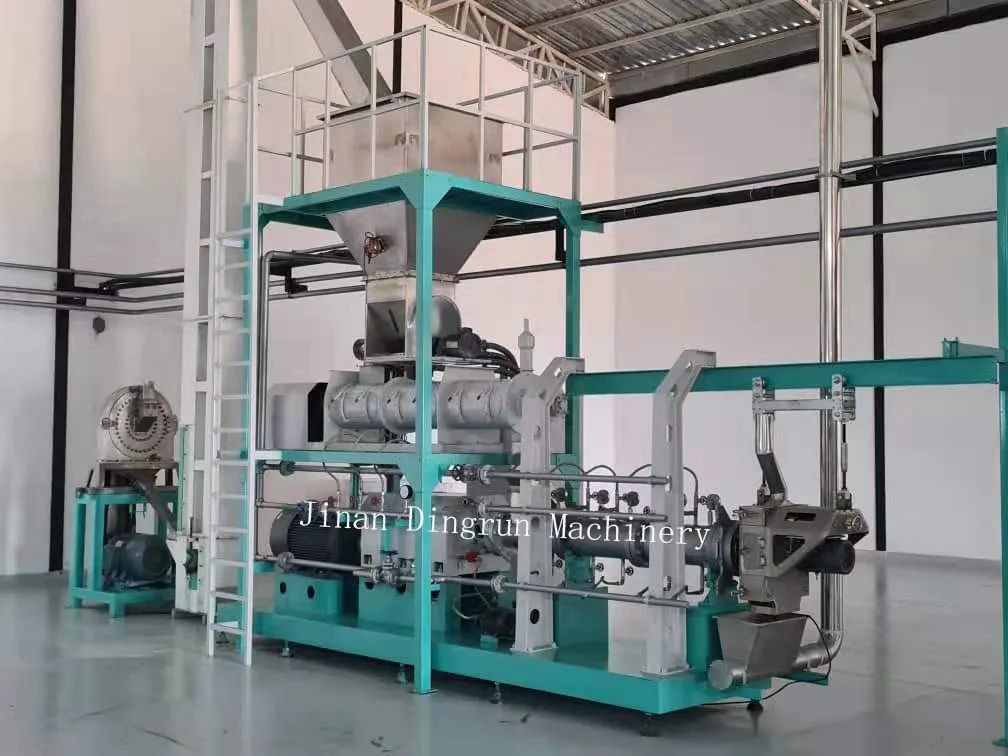
Dse-95s produces 3-4 tons per hour
